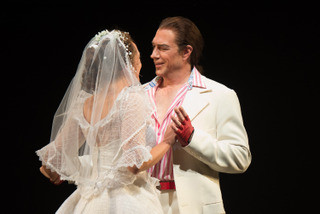|
Back
Don Giovanni reprisal improves on 2007 production Seattle
McCaw Hall
10/18/2014 - & October 19*, 22, 25, 29, 31 and November 1, 2014
Wolfgang Amadeus Mozart: Don Giovanni, K. 527
Mark Walters*/Nicolas Cavallier (Don Giovanni), Alexandra LoBianco*/Erin Wall (Donna Anna), Elizabeth Caballero (Donna Elvira), Randall Bills*/Lawrence Brownlee (Don Ottavio), Ashraf Sewailam*/Eric Anstine (Leporello), Cecelia Hall (Zerlina), Evan Boyer (Masetto), Jordan Bisch (Commendatore)
Seattle Opera Orchestra and Chorus, Gary Thor Wedow, (Conductor)
Chris Alexander (Stage Director), Robert Dahlstrom (Set Designer), Marie-Therese Cramer (Costume Designer), Duane Schuler (Lighting Designer)

C. Hall & M. Walters (© Elise Bakketun)
Warhorse or not, this Don Giovanni takes us for a sublime ride. A second one.
The production reprises Seattle Opera’s 2007 hit, so original in staging, set design, costumes, and pacing that it left audiences with a masterpiece impossible to pigeonhole by period.
And that concept carries on. Look out for tattoos, a mention of “Pulp Fiction,” Don Giovanni’s fingerless red gloves and motorcycle, and Don Ottavio’s conservative suit and natty silk scarf. But. There are period costumes, too (a masked ball comes in handy). Director Chris Alexander knows how to mix things up and keep them fresh.
And now the opera has outdone itself. This season is the last planned by Speight Jenkins, now retired longtime Seattle Opera leader, and it’s apparent he wanted to leave his following with solid memories.
An all-new cast of stellar singers includes buff baritone Mark Walters playing the dashing Don who is as accomplished and charismatic as Polish sexpot Mariusz Kwiecien, who performed the part in 2007.
The opera has seven big singing parts and features three super sopranos, especially in Cuban diva Elizabeth Caballero as Donna Elvira. Other high notes: the rounded tenor of Randall Bills as weakling Don Ottavio; conductor Gary Thor Wedow leading a flawless orchestra; and several crucial tightened-up details.
Designer Robert Dahlstrom’s set is timeless as well. Intricately connected doors that operate as elevators, balconies, bedrooms, ballrooms, park and village gates, dining areas, and finally, the entrance to hell, the set conveys sleek modernism yet works with the gorgeous, era-defying costumes by Marie-Therese Cramer (also a regular Alexander collaborator). In concert with dramatic lighting (the Don’s descent into a fiery hell counts as only one lighting high point), this Giovanni falls in league with the most visually arresting operas Seattle has done – and the company is big on beautiful design.
In my Mozart-loving opinion, Don Giovanni is the boldest and most evolved of W. Amadeus Mozart’s operas in terms of music and character. Meshed with the libretto of Lorenzo da Ponte, a womanizer himself, the piece echoes Shakespeare with its many-layered characters, patterns of speech/song dependent on class, and the inevitable reversals of plot. It combines tragedy and comedy in a genre that Mozart called “dramma giocoso,” or “joking drama.” High and low art play off each other. The subtitle of Don Giovanni is Il dissoluto punito (The Dissolute Man Punished), and surely bad-boy DG pays for his shallow pranks and unbridled libido by being dragged into hell. His life is fantasy and nightmare, cruelty and thrill. The opera, like the Don, thrives on opposites.
And the Don is never beyond a gotcha-joke. In the first act, he boastingly displays Donna Anna’s shocking pink bra after seducing her and sliding out of her bedroom’s window on a string of knotted sheets.
Speaking of sheets, an added detail in this production, left out in 2007, is the final wall of white that falls after the Don tumbles into hell and leaves his victims alone to mourn, cheer, and contemplate his death. An eeriness chills the stage: the people he abused are left in the world without him. Forgiveness? Acceptance? Aloneness? A loss of innocence? Ambiguity, in this case, means good art, especially when we are left with compelling questions surrounding an age-old (and ageless) much performed opera.
The piece is 3 hours and 30 minutes, with two acts, each approximately 85 minutes long. Be ready to spend some time in a seat, worth every moment.
Angela Allen
|